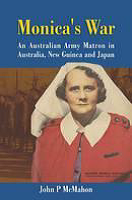John McMahon has written of the life of his aunt Monica McMahon with the greatest admiration for her and all the nursing and medical professionals she worked with during her long and productive career. Monica’s photograph is from the 27th April 1946 cover of the Women’s Weekly.
Raised on a farm North-east Victoria, Monica went to work as a tailor in a factory in the Melbourne suburb of Brunswick. Here rising to become a forewoman, she gained valuable people-management skills that served her well in the later role of matron in so many different environments. In 1931, at the age of 27, Monica commenced nursing training in Melbourne before working close to home in the Wangaratta Base Hospital. She then moved to Colac in 1937 as a triple-certificated nurse and to become Deputy Matron.
Applying to join the Australian Army in 1939, Monica was eventually accepted into the Australian Army Nursing Service (AANS) in March 1941,and in late 1941 became the matron of the Australian military hospital at Puckapunyal. Then she was a matron at the hospital at Tatura looking after Italian and German internees. Monica spent a short time on a hospital ship, and then served in eleven other Australian military hospitals that included a camp hospital at Koitaki New Guinea and the 130th Australian General Hospital at Eta Jima Island during the British Commonwealth Forces occupation of Japan. She was responsible for establishing caring teams of male and female members of the Australian Army, caring for battle casualties at the foot of the Kokoda Track and malaria and other tropical diseases in the most trying tropical conditions. Monica developed exfoliate dermatitis and was eventually brought back to Australia to Queensland and then the Heidelberg Repatriation Hospital before she was able to re-establish a fitness level that enabled her to ‘serve anywhere’.
Monica then served in Northam, WA where she nursed patients with facial wounds and post-traumatic stress disorders. A strong advocate for equal rights, Monica successfully fought for members of the AANS to nurse male patients with venereal diseases, depression and suicidal tendencies. Arriving in Japan in March 1946, one unexpected role was to teach the Japanese nurses how to care for their radiation-affected countrymen. Monica returned from Japan in 1949 and resigned her commission as a lieutenant colonel. She served in St Arnaud and Warragul Hospitals before retiring. Monica passed away in 1990.
A liberal number of coloured and black and white photographs are included in a most readable text. The endnotes and bibliography are quite comprehensive, but there being no index made it time consuming to recheck any previously-read material. This work is a testament to those who served in unforgiving conditions and gave so much to their countrymen. It provides a valuable contribution in a generally neglected aspect of Australia’s involvement in the Second ‘World War.
Reviewer: Neville Taylor, August 2016 For RUSIV

Paperback 265 pp RRP: $29.99
Contact Royal United Services Institute about this article.






